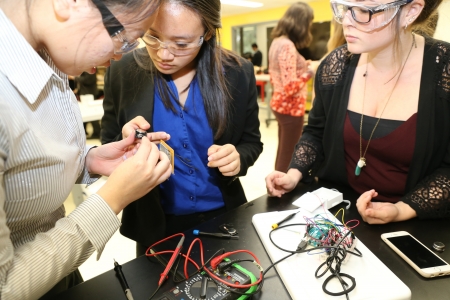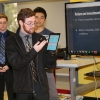Freshman Experiential Learning Course Expands; Students Design Fitness Trackers
 April 25, 2016 - From hovercrafts to quadcopters and now fitness trackers, UC Irvine engineering students are embracing the opportunity to design, build and test a multidisciplinary project in their first year of study. The first of its kind in the UC system, the Samueli School’s Introduction to Engineering class is an experiential learning course that gives students a hands-on engineering experience.
April 25, 2016 - From hovercrafts to quadcopters and now fitness trackers, UC Irvine engineering students are embracing the opportunity to design, build and test a multidisciplinary project in their first year of study. The first of its kind in the UC system, the Samueli School’s Introduction to Engineering class is an experiential learning course that gives students a hands-on engineering experience.“It’s been very rewarding for me to create this class,” says Wu. “And 91 percent of this year’s enrollees surveyed said they would recommend the course to incoming freshmen.”
The project-based course introduces students to basic fabrication skills such as hand tools, machining, woodworking and simple electronics. During lab sessions, they learn how to use computer-aided-design (CAD) software and program microcontrollers. They are taught the concepts of product development, project management, technical communication and the importance of teamwork. Many students cite teamwork as key to their project’s success. The course also gives students an overview of the engineering disciplines offered at the school. The main goal is to motivate and retain students’ interest in engineering.
Now in its fourth year, the program continues to expand and develop. For the first two years, students built hovercrafts; now they’re building quadcopters.
“We wanted our students to apply the engineering design process to a prototype that has the potential to become a real product. Drones can be used in a variety of applications – package delivery, communications for military, or filming for movies are just a few examples,” Wu says.
Thirty teams (165 students) completed the quadcopter autonomous mapping challenge this year. The quads had to use sensors to detect four objects, then, based on coordinates of a specific object, wirelessly transmit and light up a specific color on a LED panel. Team Tech-no-logic successfully completed all the tasks for the win.
In response to student and faculty input for more variety of projects, Wu consulted with the Freshman Program Faculty Advisory Committee and at the suggestion of biomedical engineer Bernard Choi, they decided to try a fitness tracker. It would involve biomedical, electrical, chemical and computer science engineering disciplines, making it a good alternative to the more mechanical and aerospace-based quadcopter. So, during winter quarter, 23 students working in four teams took on the challenge of designing a fitness tracker.
The multidisciplinary project required students to learn Arduino coding, develop an algorithm to interpret accelerometer data to count a person’s steps, create a mobile app as well as construct a wristband that would contain all the electrical components.
“Each of the teams had a strength above the others,” says Amy Dunford, a grad student in mechanical and aerospace engineering and the teaching assistant who ran the class. “ArduinoYes created the most compact electronic assembly, KCB Fitness created the most visually appealing and compact wristband, Muffin Tops had the most accurate step-count algorithm and data transfer, and Step It Up had the most user-friendly and robust mobile app.”
The majority of the students who participated in the fitness tracker pilot course were satisfied or very satisfied with the experience, based on their evaluation surveys. Student comments showed they liked having a second project option: “Having two different projects exposes students to much more content,” “It gives us a chance to try different disciplines,” and “Overall I think this was a very fun and helpful class, I would definitely take it again. Course material was interesting and we had a very good TA.”
- Lori Brandt


